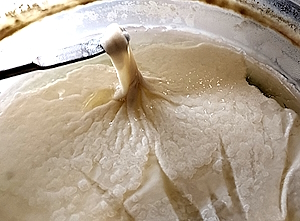The Maturation of a Bio-Polymer
Clifford E Carnicom
May 07 2024
If there is anything to be stressed in the importance of this paper, it is that the primary polymer from the Cross Domain Bacteria (CDB) (nomenclature, 2014) gets bigger, stronger, and better at clotting and transforming the blood with the passage of time. This, therefore, reiterates the fact that efforts to resolve the damage to human health are on on the losing end if they are dealt with after the fact, i.e., after the formation of the polymer itself.
The actual process displayed requires a minimum of three months to complete. What is shown in this paper is not an accident, nor an accidental discovery. It is the result of approximately five separate generations of culture research over a period of 25 years. It may be relatively simple to produce now under the proper conditions, but it is not simple in its nature nor in its consequences. Plan ahead…
The following photographs represent the development of the primary observable and repeatable polymer from the CDB. There are three variations of polymers that have been described within previous research, but this form can be accepted as the epitome of the induced mayhem.
You may find this polymer first reported on in the paper Pandora’s Polymer : Synthetic Blood and the Cross Domain Bacteria (CDB), (Feb 2024). The differences from time passage will be reported here.
Bear in mind that the influence of the Covid Era is not operative here. No “vaccine” is required to produce this lethal construct that appears to go a long way toward explaining the nature of blood clotting as it is now commonly reported. The role of the Covid Era is not diminished by this author in any respect, and perceptions of that relationship are discussed in more detail in the paper, Blood, Covid & Cross Domain Bacteria (CDB) : Emerging Relationships (Feb 2024). Although “vaccines” are not required to produce the results below, it is difficult to see them in any light other than aggravating and compounding the threat, as discussed previously.
As will be seen, it appears best to classify the creation as a unique, complex and capable synthetically created “bio-polymer”, as opposed to attempting to identify it as any simplistic, known, or commonly existing polymer.
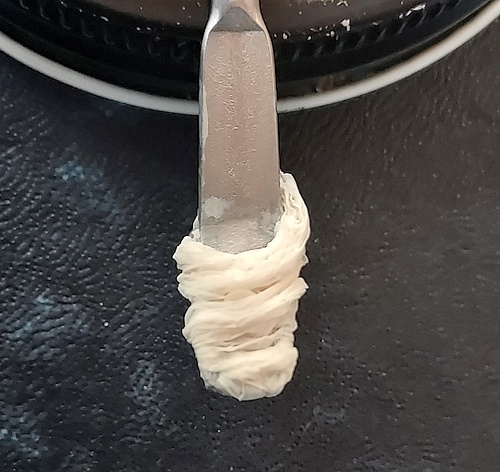
The form of the CDB primary polymer in Feb 2024. Incubation period ~30 days.
Cohesive enough to be wound, with gentle care, into a spool.
Analysis of constitution at this stage is available
within previous research.
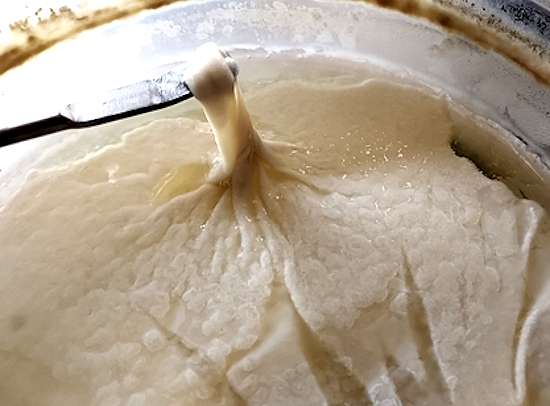
The CDB primary polymer in May 2024. Incubation period ~90 days.
Considerable increase in the strength, elasticity and cohesion of the polymer.
Analysis of constitution information discussed below.
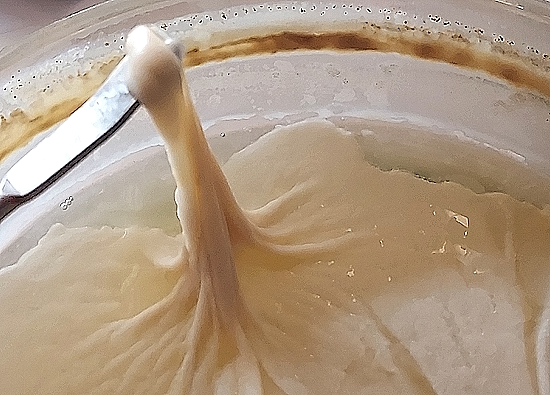
An additional view of the CDB primary polymer in May, 2024.
Incubation period ~90 days.
Even greater surface tension applied to sample.
Sample shows considerable increase in strength and elasticity.
Properties more akin to a rubber product than a surface layer.
The digest version of this paper ends here. From hereon, more detail with greater consequence will be required.
End of Summary
________________________________
________________________________
One of the goals in the identification process is to attempt to reduce something to its simplified or purified form. Much effort must be extended to equate any properties with known substances or materials; that route is not possible in this case. We are dealing with a unique biological creation here. Already understanding that synthetic biology is at the crux of Carnicom Institute‘s (CI) research, we should not actually be surprised.
Efforts were made in that direction, however, and with preliminary information the following classes of polymers at least come forth for consideration:
1. Polyvinyl chloride (PVC): (C-Cl bonds and CH2 bending aligns with PVC)
2. Nitrile rubber (NBR): (C-N and elasticity)
3. Polyamides (Nylons): (C-O-N, CH2 groups, amides)
4. Polyurethanes (PU): (C-O, C-N, CH2, amines)
The difficulty that arises is that no single class comes out completely dominant in this initial investigation. There is another aspect, however, that does come forth and completely dominates the landscape. This is biology, and in this case, it is most definitely synthetic biology. This aspect is most easily demonstrated with the use of microscopy.
Under the microscope, any common polymer would reasonably be expected to present a fairly uniform structure. Fairly uninteresting, from the microscopy point of view. As is seen below, this is hardly the case. The polymer does not just exhibit biology, it is structurally dominated by it.
It is true that there are precedents at hand. It is known that the CDB (synthetic biology) produces synthetic blood. And it is known that cellular forms characterize this “blood”. It is also known that this synthetic blood tests positive for hemoglobin on more than one occasion. But due to the sheer mass and physical properties of the polymer, we could still anticipate an organic, uniform structure.
But it is anything but – let’s take a look..

1. Microphotograph of Bio-Polymer Components
Medium Density View
Original magnification ~3000x.
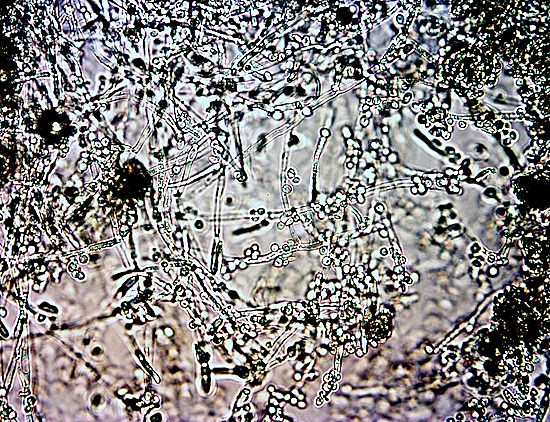
2. Microphotograph of Bio-Polymer Components
Higher Density View
Original magnification ~3000x.
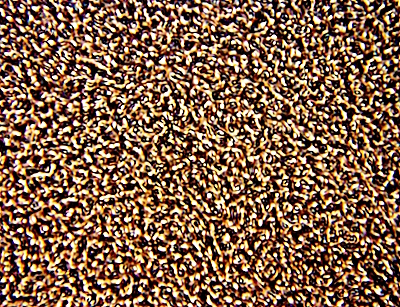
3. Microphotograph of Bio-Polymer Components
High Density View
Original magnification ~6250x
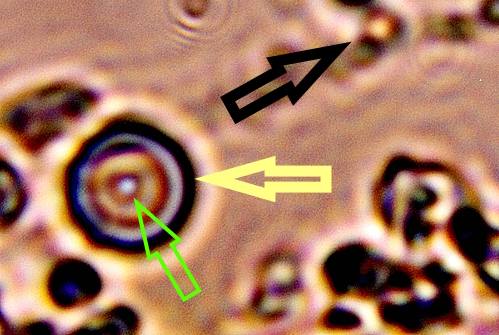
4. Microscopic Isolation of Bio-Polymer Components
Yellow Arrow : Fully developed synthetic erythrocyte (~6.5 microns (um) diam.)
Black Arrow : Isolated CDB (~ 0.5 to 0.8 um diam.)
Green Arrow : Centralized CDB within synthetic erythrocyte (a common observation)
Original magnification ~6250x
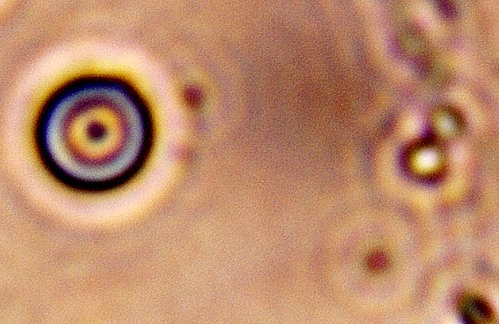
5. Additional example of isolation of Bio-Polymer
developed synthetic erythrocyte (~6 um diam.) to left
and CDB to right. Original magnification ~6250x

6. Microscopic isolation of CDB cluster within Bio-Polymer
Original magnification ~6250x
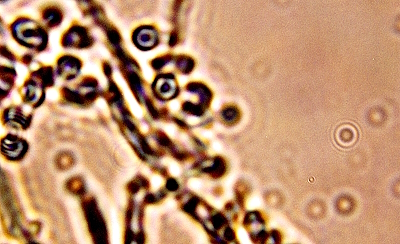
7. Bio-Polymer filament, undeveloped synthetic erythrocytes and CDB.
Original magnification ~6250x
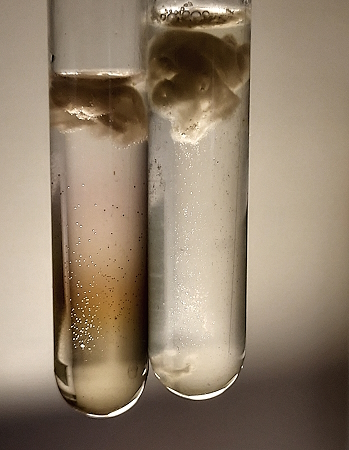
8. Solubility Testing of Bio-Polymer:
Left : Exposure of CDB bio-polymer to
strong sulfuric acid – room temperature
RIght : Exposure of CDB bio-polymer to strong
sodium and potassium hydroxide – room temperature
Note weak color tints on left trial.
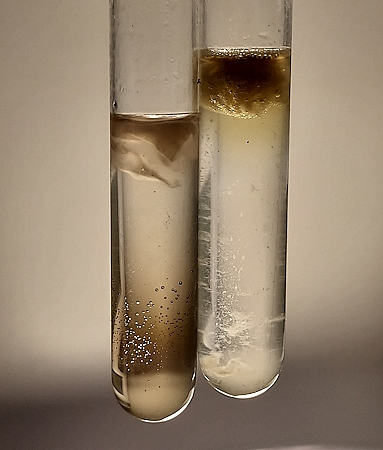
9. Solubility Testing of Bio-Polymer:
Left : Exposure of CDB bio-polymer to
strong sulfuric acid – heated to 90 deg. C.
RIght : Exposure of CDB bio-polymer to strong
sodium and potassium hydroxide – heated to 90 deg. C.
Note weak color tints on both left and right trials.
Some additional comments can and should be made on some of the photographs above:
Photograph No. 3:
This photograph displays what might be expected to be seen, but at the same time gives a false impression. It is often valuable to study a microscopic slide in some detail. If one is seeking out an apparently uniform texture or structure for the bio-polymer, this is probably the place to attempt to satisfy that expectation. Although not of singular structure, it is nevertheless fairly uniform. This is because of the density of the slide at this location, and it belies the actual and important variation that takes place within the slide upon more detailed inspection. Furthermore, that variation is almost all or entirely biological in its nature. This changes the interpretation of the nature of the polymer in a substantial way, even though a macro view might lead one to think the polymer is of a uniform “rubber” nature, for example. This is not the case; it’s nature is dominated by biology (synthetic).
Photographs 1 and 2:
Photographs 1 and 2 demonstrate that biological nature very clearly. This represents somewhat of a disconnect between the macro view shown at the onset of the paper, and the microscopic view of this set. The microscopic view wins out in the search for the intrinsic nature of the polymer. It is at this point that the four traditional classes of polymers mentioned above become completely inadequate to describe the complexity and biological nature of the polymer. These four simpler classes of polymer are not excluded since the properties of each remain shared, but traditional polymer definition becomes subservient at this point. It is here that we learn that a unique synthetically derived biological polymer is in place.
Photographs 4 and 5:
Next we must bring into prominence the blood issue, which is embedded within CI research for decades, and that without any doubt is at the heart of the synthetic biology issue. This brings us to a central tenet once again, and this is that the “Geoengineering”, “Morgellons” and “Covid Era” issues are of one and the same thing.
The “geoengineering” issue was and is falsely presented, intentionally, from the beginning as to its scope and purpose. I would suggest that efforts be made to seek out two prior presentations by Carnicom Insitute in years past. The title of both presentations was equivalent and it was:
“Geoengineering and Bioengineering : The Unmistakable Link”.
The “Morgellons” issue was and is also falsely presented, intentionally as to its scope and extent. “Morgellons” is a case of induced synthetic biology without knowledge or consent upon the global population. “Delusion” characterization and restriction of scope were both highly successful psychological and information management operations.
The Covid Era, although still improperly defined from any scientific viewpoint, is without any doubt another extension of the synthetic biology transformation of the human race underway.
It is not advancing to continually repeat what has been established clearly within the research. The common denominator of change to the human race and biology in all cases is the Cross Domain Bacteria (CDB).
Photographs 4 and 5 show the critical players again. No further explanation is required.
The fact that the composite set of photographs above are at the crux of the health threat can be further affirmed with a visit to previous collaborative work with Dr. Ana Mihalcea, Blood Clot Analysis From Living & Deceased Individuals Shows Consistent Findings: A Rubber Like Polymerized Protein, Jul 2023.
The same, the same, the same..
What differs is that the bio-polymer studied here originates in a controlled environment, rather than a human being. This provides many advantages to our current and future understanding of the battlefield.
Photographs 8 and 9.
These photographs are important for a couple of reasons:
1. They make the case that you do not want these polymers in your body. You will have a very hard time ridding yourself of that problem. The polymers require interruption and disruption to CREATION and FORMATION, not existence. Previous papers make this point as well.
2. The color tints are important for a couple of reasons. Previous work has established that the synthetic blood does contain hemoglobin. All indications, including the spectroscopy applied during this particular study, continues to verify the existence of hemoglobin. The red tint is one of the clues to help identify its origin, and in this case all roads lead to hemoglobin, over and over. The difference and the problem? The bio-polymer originates from synthetic biology, and the hemoglobin the same.
The second thing that can be learned from the presence of color tints showing is that transition metals are most certain to exist in the polymer; iron is already known to be a mainstay. Notice that it requires strong acids and caustics to reveal this color presence. This is a feature hidden from observation of the smooth white, rubber texture of the polymer alone.
______________________________
The methods of investigation for this paper include:
1. Mid infrared spectroscopy (Raman)
2. Near infrared spectroscopy
3. Ultraviolet spectroscopy
4. Visible light spectroscopy
5. Microscopy
6. Solubility studies
7. pH studies
______________________________
Summary Assessment:
The refined assessment of the primary polymer produced by the CDB transitions is that of a complex Bio-Polymer. It is not likely fruitful to attempt to classify the polymer as something of known form or identity. The biological nature of this polymer dominates the structural or texture macro qualities. The Bio-Polymer is of synthetic biology origin, and is by observation and study, extraordinarily complex. Synthetic blood and hemoglobin production by the CDB are at the heart of the polymer function. Interactions of the synthetic blood and synthetic hemoglobin with human blood are an inevitable consequence; blood clotting of a lethal nature is one of these apparent. The Bio-Polymer appears to be visually and chemically identical to human blood clots that have been removed and studied in association with contemporary Covid Era concerns. The Bio-Polymer can be produced by the CDB in a controlled and repeatable fashion.
______________________________
Post Notes:
I had no desire to write such a lengthy paper here, but apparently it was required. I have another half dozen papers immediately on tap, and I can’t say exactly that I have the time and means to devote. Patience.. There is competition between active research, research presentation, and research transfer and distribution.
I will more frequently express this clarion call for the latter competition. Please take note of this statement made previously:
“All CI work is to serve the public interest and welfare at all times. Carnicom Institute will require that certain and further advanced discretionary disclosures, should they occur on this and related work, are directed to serve the public welfare and non-profit motives. The rights of public and affordable access to all benefits that may ensue are inherent. Interested parties, operating at the directorate or managerial level of such organizations or effort, are welcome to contact Carnicom Institute [info@carnicominstute.org]. A history of charitable public service (in any and all professions) is paramount in any consideration. Any coordination should be viewed in terms of planning prospects only.”
If you would like to assist in the accelerated transfer of additional laboratory accomplishment to the general public and professional communities, please consider doing exactly as is requested above. Please make an effort to put charitable organizations that meet the criteria above in contact with Carnicom Institute. In addition, please download the additional resources that are available at the CI Library portal. Thank you.
Additional note: Communication blockage is now active.
Alternate email address: carnicominstitute@protonmail.com
Mail: Carnicom Institute PO Box 105 Alberton MT 59820
With best regards,
Clifford E Carnicom
born Clifford Bruce Stewart, Jan 19 1953.

